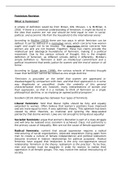Feminism Revision
What is feminism?
A simple of definition would be from Brown, GW, McLean, I, & McMillan, A
2018: ‘if there is a universal understanding of feminism, it might be found in
the idea that women are not and should be held equal to men in social,
political, and economic life from the household to the international arena’.
According to McAfee (2018) there are two ways in which feminism can be
defined. It can be defined in a normative sense, which concerns how women
ought and ought not to be treated. The descriptive sense concerns how
women are and are not treated. Together, these two claims provide the
intellectual and ideological foundations of feminism, making it a political
movement. Due to the various schools of thought, this is the simplest
definition of feminism, as different schools define it differently. McAfee’s
simple definition is: ‘feminism is both an intellectual commitment and a
political movement that seeks justice for women and the end of sexism in all
forms’.
According to Susan James (1998), the various schools of feminist thought
mean that feminism cannot be viewed as one single doctrine:
‘Feminism is grounded on the belief that women are oppressed or
disadvantaged by comparison with men, and that their oppression is in some
way illegitimate or unjustified. Under the umbrella of this general
characterisation there are, however, many interpretations of women and
their oppression, so that it is a mistake to think of feminism as a single
philosophical doctrine, or as implying an agreed political program’.
Goodwin (2014) distinguishes between four types of feminists:
Liberal feminists: hold that liberal rights should be fully and equally
extended to women. Often believe that women’s positions have improved
and are more equal to men. A very optimistic theory. This optimism has been
viewed by other theorists, as irrational and ignoring the deep-seated
patriarchy that dooms women. Laws are not enough to bring about equality!
Socialist feminists: argue that women’s liberation is part of a class struggle
and will only be realised once socialism is achieved. Class, not patriarchy is
the primary cause of inequality. Men are not the cause of female oppression!
Radical feminists: content that sexual oppression requires a radical
restructuring of social organisations. Advocate separatism (living apart from
men to create a culture of female independence) and political lesbianism
(become involved in lesbian relationships for political purposes’. Radical
feminists have argued that lesbianism is the only non-oppressive sexual
relationship ‘feminism is the theory; lesbianism is the practice’. To be free,
men and women must be separate in order for women to realise their
oppression in all-female groups. This may involve the radical restructuring of
society.
, Postmodern feminists: use the insights of postmodernism to question
gender-based norms. They seek to destabilise patriarchal norms which have
been used to suppress women by embracing the differences that exist among
women to demonstrate intersectionality. If a universal truth is applied to all
women, the differences between the female experience is negated and this
may stem from masculine norms of how women should be depicted (Wallin,
2001). Women must be critical of the standard views promoted in society, as
they may have masculine notions. Postmodern feminism suggests that a
single-strategy of emancipation and empowerment is not inclusive and
promotes gender-based assumptions of what women are and what we should
be.
(from Goodwin, 2014).
Feminists and Feminist theorists ask whether female human nature
Human Nature contrasrs with male human nature, and commonly
conclude that there is no difference. Any assumption
that biological difference should lead to differential
treatment, is patriarchal. Shulamith Firestone, a Radical
Feminist, has argued that biological difference are the
causes of female oppression, even stating that
‘pregnancy is barbaric’ and artificial reproduction is the
only means of securing liberation for women. However,
other feminists, such as Pateman have argued that this
critique is too intense and radical to obtain any respect
or theoretical foundation within feminism. Biological
differences should not equate inequality; instead,
inequalities have been socially constructed.
Non-feminists, such as Wilson (psychologist), have
argued that there are psychological differences
between the genders and therefore ‘differences are
largely innate’ and sexual equality is null and void.
Women who succeed in dominantly ‘male’ spheres do
so because they had been masculinised in their
childhoods.
However, postmodern feminists such as Wallin, confront
Wilson on why certain spheres are even perceived as
male in the first place! Male notions of masculinity and
femininity need to be challenged in order for women to
be emancipated.
Feminist Sexual differences are not innate are instead the
Perceptions of product of gendered society. Non-feminists, such as
a Gendered Rousseau, who have wished to characterise women as
Society ‘weak and passive’ are forcibly repressing women (JSM).
Inequalities between the sexes come from society. The
patriarchy actively attempts to devalue feminine
characteristics in the lives of children to reproduce
gender roles.
Feminist Zillah Eisenstein define ‘patriarchy’ as a ‘system of
Perceptions of oppression’. With the sole purpose of ‘destroy[ing]




